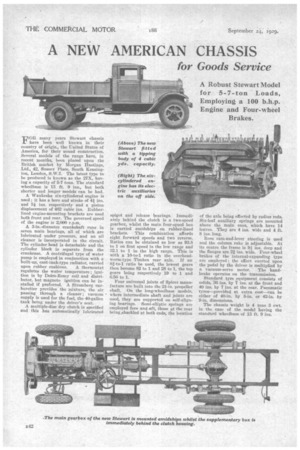A NEW AMERICAN CHASSIS
Page 68

If you've noticed an error in this article please click here to report it so we can fix it.
for Goods Service
-Dort many years Stewart chassis V have been well known in their country of origin„ the United States of America, for their sound construction. Several models of the range have, in recent months, been placed upon the British market by Morgan Hastings, Ltd., 42, Sussex Place, South Kensington, London, 8.W.7. The latest type to be produced is known as the 27X, having a capacity of 5-7 tons. The standard wheelbase is 13 ft. 9 ins., but both shorter and longer models can be had.
A Waukesha six-cylindered engine is used ; it has a bore and stroke of 41 ins. and 51 ins, respectively and a piston displacement of 462 cubic ins. Rubberlined engine-mounting brackets are used both front and rear. The governed speed of the engine is 2,000 r.p.m.
A 3-in.-diameter crankshaft runs in seven main bearings, all of which are lubricated under pressure, and an oil cleaner is incorporated in the circuit. The cylinder head is detachable and the cylinder block is separate from the crankcase. A centrifugal type of water pump is employed in conjunction with a built-up, cast-tank-type radiator, carried
upon rubber cushions. A thermostat regulates the water temperature' ignition is by Delco-Remy coil and distributor, but magneto ignition can be installed if preferred. A Stromberg carburetter provides the mixture, the air passing through a cleaner ; vacuum supply is used for the fuel, the 40-gallon tank being under the driver's seat.
A multiple-disc dry clutch is specified and this has automatically lubricated spigot and release bearings. Immediately behind the clutch is a two-speed gearbox, whilst the main four-speed box is carried amidships on rubber-lined brackets. This combination affords eight forward speeds and two reverse. Ratios can be obtained as low as 93.8 to 1 on first speed in the low range and 32.1 to 1 in the high range. This is with a 10-to-1 ratio in the overheadworm-type Timken rear axle. If an 81-to-1 ratio be used, the lowest gears then become 82 to 1 and 28 to 1, the top gears being respectively 19 to 1 and 6.56 to 1.
Four universal joints of Spicer manufacture are built into the 2i-in. propeller shaft. On the long-wheelbase models, where intermediate shaft and joints are used, they are supported on self-aligning bearings. Semi-elliptic springs are employed fore and aft, those at the rear being shackled at both ends, the location of the axle being effected by radius rods. Six-leaf auxiliary springs are mounted above the main ones, which have 14 leaves. They are 4 ins, wide and 4 ft. 8 ins. long.
Ross cam-and-lever steering is used and the column rake is adjustable. At its centre the frame is 9+ ins. deep and the flanges are 21 ins. wide. Four-wheel brakes of the internal-expanding type are employed ; the effort exerted upon the pedal by the driver is multiplied by a vacuum-servo motor. The handbrake operates on the transmission.
Standard tyre equipment consists of solids, 36 ins. by 7 ins, at the front and 40 ins. by 7 ins, at the rear. Pneumatic tyres—provided at extra cost—can be either of 40-in. by 8-in. or 42-in. by 9-in. dimensions.
The chassis weight is 4 tons 3 cwt. in the case of the model having the standard wheelbase of 13 ft. 9 ins.




















































































































